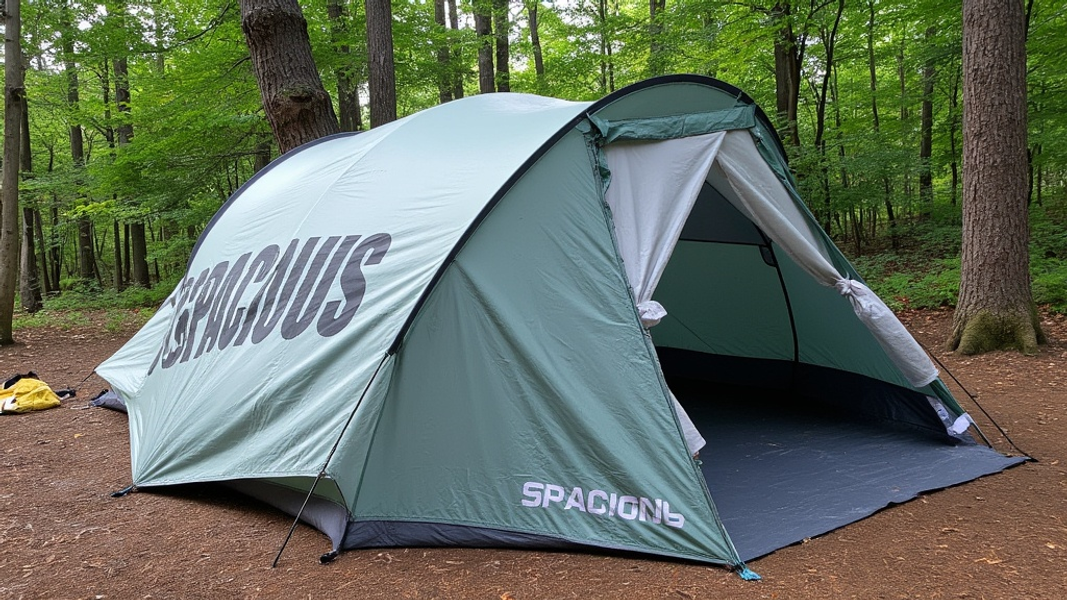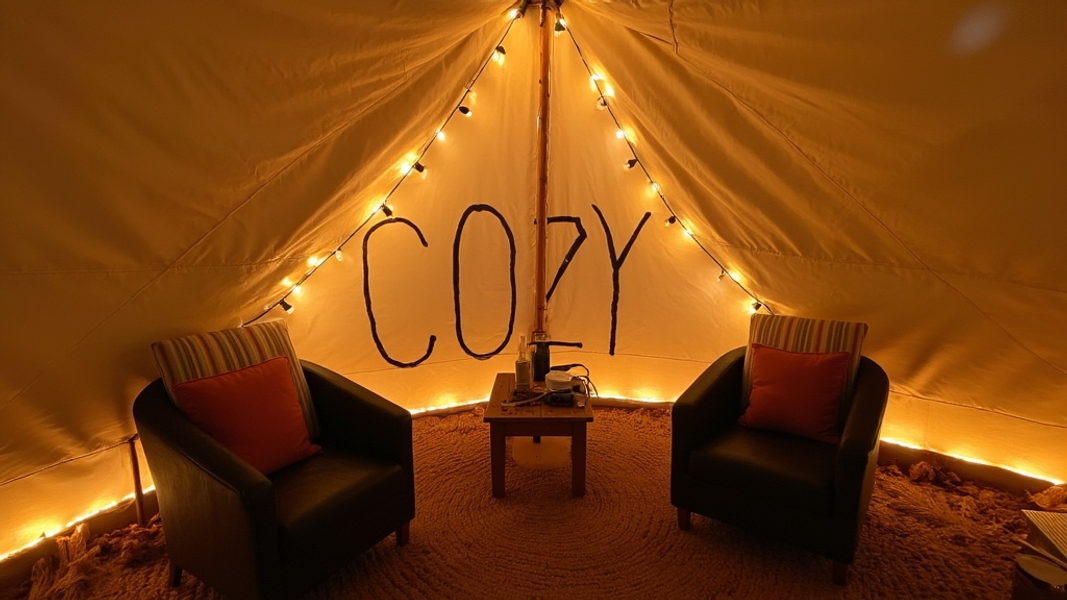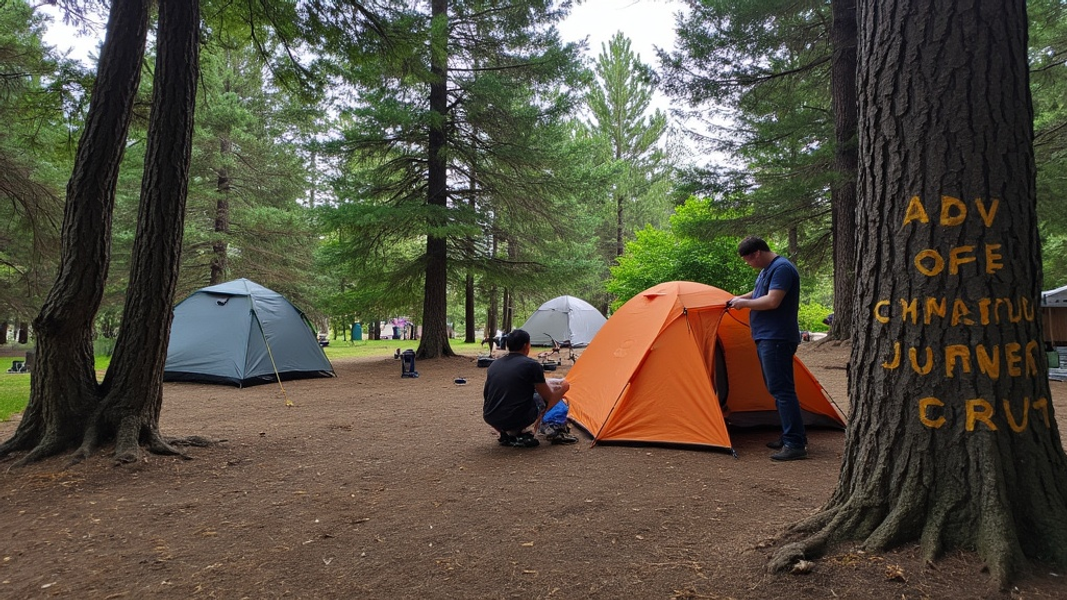From solo backpackers to large families, find the ideal tent size for your outdoor adventures
Have you ever tried to cram your family into a tent that felt more like a shoebox than a cozy shelter? We've all been there. Picking the right tent size can make or break your camping trip. But don't worry! This guide will help you find the perfect tent for your next outdoor adventure.
Understanding Tent Sizing Basics
When you're shopping for a tent, you'll see numbers like "2-person" or "4-person" tent. But these labels can be tricky. They don't always tell the whole story.
What Those Numbers Really Mean
Tent makers use these numbers to show how many people can sleep in the tent. But they often assume you're packed in like sardines. In real life, you need more space than that.
For example, a "2-person" tent might fit two sleeping bags side by side. But it won't have room for your bags or gear. And forget about standing up or moving around!
Why Size Matters
The right tent size can make your trip much more fun. You'll have space to sleep, store your stuff, and maybe even play cards if it rains. A tent that's too small can make you feel cramped and grumpy.
But a tent that's too big has problems too. It can be heavy to carry and hard to set up. It might also be cold because your body heat can't warm up all that extra space.
How Much Space Do You Really Need?
A good rule of thumb is to allow about 30 square feet per person. This gives you room to sleep and store some gear. If you like more space or have lots of stuff, aim for 40 square feet per person.
Let's do some math. For a family of four, you'd want at least 120 square feet (30 x 4). That's about the size of a small bedroom. If you want extra comfort, go for 160 square feet or more.
Common Tent Sizes and Their Real-World Capacity
Now that we know the basics, let's look at different tent sizes and what they're really good for.
1-2 Person Tents
These small tents are great for solo campers or couples who like to travel light. They're easy to carry and set up. But they're snug!
A typical 1-2 person tent might be about 7 feet long and 5 feet wide. That's enough room for two sleeping bags, but not much else. You'll probably need to keep your backpacks outside under a rain fly.
These tents are perfect for:
- Backpackers who want to travel light
- Solo campers who don't mind close quarters
- Couples on short trips who don't need much gear
The REI Co-op Passage 2 is a good example of a 2-person tent. It's light enough to carry on a hike but still has room for two.
3-4 Person Tents
These mid-size tents are great for small families or couples who want extra space. They often have room for a few sleeping bags and some gear.
A 3-4 person tent might be about 9 feet long and 7 feet wide. That's enough room for three adults to sleep comfortably, or two adults and two small kids.
These tents work well for:
- Small families with young kids
- Couples who want space for gear
- Friends who don't mind sharing close quarters
The Coleman Sundome 4 is a popular 4-person tent. It's easy to set up and has enough room for a family weekend trip.
6-8 Person Tents
Now we're talking about big tents! These are great for families or groups of friends. They often have separate rooms or areas for sleeping and hanging out.
A 6-8 person tent might be 12 feet long and 10 feet wide. That's enough room for two queen-size air mattresses or several sleeping bags. You'll have space to stand up and move around too.
These tents are ideal for:
- Families with older kids who want privacy
- Groups of friends camping together
- Car campers who don't mind a heavier tent
The North Face Wawona 6 is a great 6-person tent. It has a big main room and a separate vestibule for gear storage.
10+ Person Tents
These are the giants of the tent world. They're huge and can fit a whole crew. But they're also heavy and can be hard to set up.
A 10+ person tent might be 20 feet long and 10 feet wide or even bigger. That's like a small apartment! You'll have room for several air mattresses, chairs, and maybe even a table.
These massive tents work best for:
- Large family reunions
- Group camping trips
- Long-term camping setups
The Ozark Trail 12-Person Cabin Tent is a popular choice for big groups. It has separate rooms and enough space for everyone.

Special Considerations for Different Camping Styles
Your camping style can make a big difference in what tent size you need. Let's look at some common types of camping and what to think about for each.
Backpacking Tents
When you're carrying everything on your back, every ounce counts. Backpackers need tents that are light and pack small. But you still want to be comfortable at night.
For backpacking, look for tents that weigh less than 5 pounds for two people. These tents might be a bit smaller than car camping tents, but they're easier to carry.
Some backpackers even use "ultralight" tents that weigh less than 2 pounds. These are super light but might not be as sturdy in bad weather.
The Big Agnes Copper Spur HV UL2 is a popular backpacking tent. It's light but still has room for two people and some gear.
Car Camping Tents
When you're driving to your campsite, you can bring a bigger, heavier tent. This means more comfort and space!
Car camping tents often have extra features like room dividers, big doors, and lots of pockets. They might be heavier, but that's okay because you don't have to carry them far.
Look for tents with high ceilings so you can stand up inside. Extra vestibules (like little porches) are great for storing dirty shoes and gear.
The REI Co-op Kingdom 6 is a fantastic car camping tent. It's big, comfy, and has lots of great features.
Family Camping Tents
Camping with kids? You'll want a tent with some extra features. Look for tents with room dividers for privacy. This lets parents have their own space away from the kids.
Family tents often have big doors that are easy for little hands to open. Lots of pockets help keep things organized. And a big vestibule gives you a place to take off muddy boots before going inside.
Some family tents even have special "dark room" technology. This keeps the inside darker so kids (and parents!) can sleep later in the morning.
The Coleman WeatherMaster 6-Person Tent is great for families. It has a separate screen room that's perfect for playing games or eating meals.
<iframe width="560" height="315" src="https://www.youtube.com/embed/ufvdWafV0jY" title="Guide Gear Full Size Truck Tent" frameborder="0" allow="accelerometer; autoplay; clipboard-write; encrypted-media; gyroscope; picture-in-picture; web-share" referrerpolicy="strict-origin-when-cross-origin" allowfullscreen></iframe>How Tent Shape Affects Usable Space
The shape of your tent can make a big difference in how much space you actually have. Let's look at some common tent shapes and what they offer.
Dome Tents
Dome tents are shaped like, well, a dome! They're round at the top and slope down to the ground. These tents are great because they're sturdy and can handle wind and rain well.
But dome tents have a downside. The sloping walls mean you lose some space around the edges. You might only be able to stand up right in the middle.
Dome tents are good for:
- Camping in windy areas
- Backpackers who want a sturdy, lightweight tent
- Small groups who don't need tons of headroom
Cabin-Style Tents
Cabin tents have straight walls and a flat roof. This means you get more usable space inside. You can often stand up everywhere in a cabin tent, not just in the middle.
These tents are great for families or groups. They often have room dividers to create separate spaces. But they're not as good in strong winds because of their boxy shape.
Cabin tents work well for:
- Family camping trips
- Car camping where you want lots of living space
- Long camping trips where comfort is key
Bell Tents and Other Designs
Bell tents are big, round tents with a single center pole. They look a bit like a circus tent. These are becoming popular for "glamping" (fancy camping).
Bell tents give you lots of floor space and high ceilings. But they can be heavy and take longer to set up. They're great for long camping trips or setting up a base camp.
Other unique designs include:
- Teepee tents: Tall and cone-shaped
- Tunnel tents: Long with lots of living space
- Pop-up tents: Super easy to set up but not always as sturdy

5 Tips for Choosing the Right Tent Size
Now that we've covered the basics, here are some key tips to help you pick the perfect tent size:
-
Always size up for comfort: If you're between sizes, go bigger. You'll appreciate the extra space.
-
Think about your camping style: Backpackers need smaller, lighter tents. Car campers can go bigger.
-
Don't forget about gear: Remember to leave room for backpacks, shoes, and other stuff.
-
Consider the weather: If you camp in cold weather, a smaller tent is easier to keep warm.
-
Test it out: If possible, set up the tent before you buy it. Make sure you can move around comfortably.
Real Campers, Real Tent Choices
Let's look at some real-life examples of campers and the tents they chose:
Solo Backpacker: Sarah
Sarah loves hiking long trails. She chose the Big Agnes Copper Spur HV UL1 tent. It weighs just over 2 pounds but still gives her enough room to sleep and store her backpack.
Sarah says, "I can sit up to change clothes, and there's a little vestibule for my boots. It's perfect for me and my gear."
Family of Four: The Johnsons
The Johnson family goes car camping several times a year. They picked the REI Co-op Kingdom 6 tent.
Dad Mike explains, "We wanted room for our queen-size air mattress plus space for the kids' sleeping bags. The room divider gives us some privacy, and we can all stand up inside. It's like a little home away from home!"
Wrapping Up
Choosing the right tent size is key to a great camping trip. Remember:
- Think about how many people will use the tent
- Consider your camping style and gear needs
- Don't be afraid to go a size up for comfort
With these tips, you'll be well on your way to finding the perfect tent for your next outdoor adventure. Happy camping!
FAQs
How do I know if a tent is waterproof?
Look for tents with a high "hydrostatic head" rating. This measures how waterproof the fabric is. A rating of 1500mm or higher is good for most conditions. Also, check that the seams are sealed and the zippers have flaps to keep water out.
Can I use a 3-season tent in winter?
It depends on the conditions. A 3-season tent can work for mild winter camping. But for snow or very cold weather, you need a 4-season tent. These are stronger and better at keeping out wind and snow.
How long should a tent last?
With good care, a quality tent can last 10 years or more. But this depends on how often you use it and in what conditions. Sun, wind, and rain can wear out a tent faster. Store your tent dry and clean to help it last longer.
Is it worth buying an expensive tent?
Often, yes. Pricier tents usually have better materials and construction. They might be more waterproof, easier to set up, or more durable. But there are good tents at many price points. Think about how often you'll use the tent and in what conditions.
How do I clean my tent?
Clean your tent with mild soap and water. Don't use a washing machine or harsh cleaners. Gently scrub dirty spots with a soft brush. Rinse well and let it dry completely before storing. This helps prevent mold and keeps your tent in good shape.
